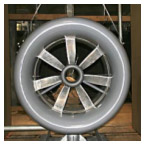Getting to Action for the Mississippi River
The Water Science and Technology Board, WSTB, announcement in July blurted out the Mighty Mississippi was suffocating and inertia was not an option. They're right. But, if inertia isn't an option, what does action look like?
The WSTB is part of the National Research Council and they just completed work on recommendations for long-term solutions to conditions in the Mississippi River Basin and the northern Gulf of Mexico. Their study's findings aren't altogether new but their suggestions for action are. The WSTB suggests a Nutrient Control Implementation Initiative. They further suggest a new Mississippi River Basin Water Quality Center. They want to see nonsource point pollution curtailed by focusing attention on the areas creating the greatest damage. That makes sense until you realize the targets are agricultural land, forests, urban lawns, streets, and paved areas. That's just about everything along the River's edge, except wilderness.
To further complicate things, the WSTB also observed the problem includes "numerous watersheds and tributaries involving a huge land mass spanning 31 states, covering approximately 41 percent of the coterminous land in the U.S. with multiple governmental authorities responsible for managing the Mississippi River Basin…."
So where would the new initiative start? And, what would the new center address in an effort to target its resources?
With this degree of complexity and this number of targets to hit, creating an initiative and a center is a little like addressing international trouble spots with military solutions alone. Sound familiar? A recent book, The Age of the Unthinkable by Joshua Ramo, posits that complex situations take more than military - or scientific - solutions alone. They take multilayered and participative approaches. The effort for a cleaner Mississippi River Basin can be promoted by identifying the problem and suggesting regulation and monitoring. But actualizing the solution requires an engaged constituency to work and support the suggested approaches, especially in these harsh economic times.
Between launching an initiative and a center with an end goal of improved water quality for the Mississippi and the Gulf, there's a lot of congressional, regulatory and budget action that needs to take place. In these cases especially, action requires informed and organized public support if it's to see the light of day. The report cites the Clean Water Act as having the authority for such initiatives, but even within the CWA there will be groups vying for the resources. So the question still remains, "What does action look like?"
This is why we've proposed A National Dialogue for the Future of America's Waterway. Designed and managed in partnership with AmericaSpeaks, this process allows for public priority setting, planning and action steps for policy outcomes. Such a Dialogue would allow Mississippi River residents to join with specific interest groups to build the public support needed to turn policy suggestions into action on behalf of the Mississippi River.

Watch America's Waterway for News from National Conference
The Visions of a Sustainable Mississippi River Conference, being held Aug. 10 -13 in Colllinsville, Ill., promises to attract participants with diverse interests in our nation's largest river. Co-hosted by the National Great Rivers Research and Education Center and The Nature Conservancy, it's a start for looking at all aspects of the Mississippi River. I will share the conference's highlights daily via America's Waterway's blog. Of great interest will be the policy forum scheduled for Aug. 13. Stay tuned at www.americaswaterway.org for daily updates and more.
RiverSphere Founded for Research on HydroKinetic Power
 A project of the Tulane/Xavier Center for Bioenvironmental Research, RiverSphere has been established to explore hydrokinetic energy. With the understanding that this new energy-producing source is not like your fathers' giant energy producing turbines, RiverSphere will use new methodologies to evaluate ecological effectiveness. Hydrokinetic technology developers - like Massachusetts' Free Flow featured in a previous River Currents - are creating small turbines to capture power from existing river currents. A project of the Tulane/Xavier Center for Bioenvironmental Research, RiverSphere has been established to explore hydrokinetic energy. With the understanding that this new energy-producing source is not like your fathers' giant energy producing turbines, RiverSphere will use new methodologies to evaluate ecological effectiveness. Hydrokinetic technology developers - like Massachusetts' Free Flow featured in a previous River Currents - are creating small turbines to capture power from existing river currents. |